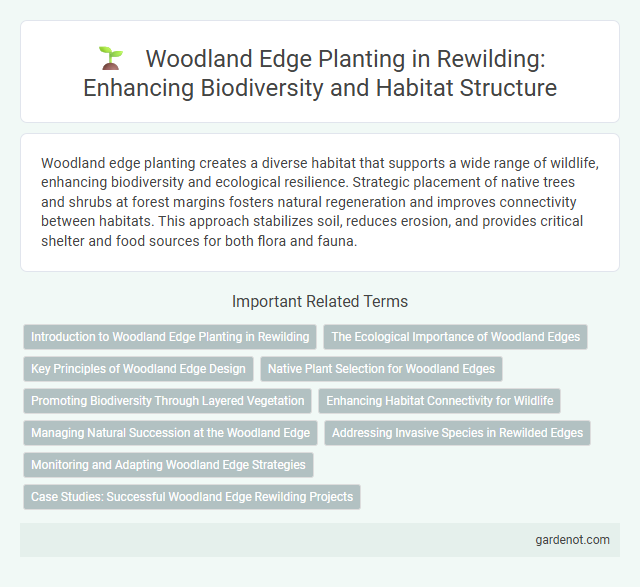Woodland edge planting creates a diverse habitat that supports a wide range of wildlife, enhancing biodiversity and ecological resilience. Strategic placement of native trees and shrubs at forest margins fosters natural regeneration and improves connectivity between habitats. This approach stabilizes soil, reduces erosion, and provides critical shelter and food sources for both flora and fauna.
Introduction to Woodland Edge Planting in Rewilding
Woodland edge planting in rewilding enhances biodiversity by creating transitional habitats between dense forest and open landscapes, supporting diverse wildlife species. Selecting native trees and shrubs such as hawthorn, blackthorn, and hazel encourages natural regeneration and promotes ecological connectivity. This strategic planting method helps restore ecosystem functions, increases habitat complexity, and benefits pollinators, birds, and mammals.
The Ecological Importance of Woodland Edges
Woodland edge planting creates vital transition zones rich in biodiversity, offering habitat diversity that supports a wide array of wildlife species. These ecotones enhance ecological connectivity by serving as corridors for insects, birds, and mammals, facilitating movement and genetic exchange between forest and open habitats. The structural complexity of woodland edges improves microclimate regulation and soil health, contributing to overall ecosystem resilience in rewilding projects.
Key Principles of Woodland Edge Design
Woodland edge planting emphasizes creating diverse habitat structures by integrating native shrub and tree species to enhance biodiversity and ecological resilience. Key principles include maximizing structural complexity to support wildlife corridors, using gradual transitions between open and wooded areas, and promoting natural regeneration processes. This approach fosters rich habitats that stabilize soil, improve microclimates, and increase carbon sequestration at the forest margins.
Native Plant Selection for Woodland Edges
Native plant selection for woodland edge planting enhances biodiversity by providing habitat and food sources for local wildlife, including pollinators and birds. Species such as hazel (Corylus avellana), hawthorn (Crataegus monogyna), and dogwood (Cornus sanguinea) thrive at woodland edges, creating natural buffers and improving soil stability. Incorporating a diverse mix of native shrubs and ground flora supports ecosystem resilience and promotes successful rewilding efforts.
Promoting Biodiversity Through Layered Vegetation
Woodland edge planting enhances biodiversity by creating layered vegetation structures that support diverse wildlife habitats. Incorporating shrub layers, understory plants, and canopy trees fosters microhabitats for pollinators, birds, and small mammals, increasing ecological complexity. This stratified planting approach improves ecosystem resilience by facilitating nutrient cycling and providing continuous food sources throughout the seasons.
Enhancing Habitat Connectivity for Wildlife
Woodland edge planting plays a crucial role in enhancing habitat connectivity for wildlife by creating transitional zones that link fragmented ecosystems. These vegetative buffers support diverse species by providing shelter, food resources, and migration corridors essential for genetic exchange and population resilience. Strategic planting at woodland edges mitigates habitat isolation, promoting biodiversity and ecosystem stability within rewilding projects.
Managing Natural Succession at the Woodland Edge
Woodland edge planting plays a crucial role in managing natural succession by creating transitional habitats that support diverse flora and fauna. Strategic planting of native species at the woodland edge helps stabilize soil, reduce invasive species encroachment, and promote biodiversity by providing food and shelter for pollinators, birds, and mammals. Effective woodland edge management enhances ecosystem resilience and facilitates the gradual expansion of native woodlands into surrounding habitats.
Addressing Invasive Species in Rewilded Edges
Woodland edge planting enhances biodiversity by creating transitional habitats that support native flora and fauna while suppressing invasive species. Targeted planting of native shrubs and trees forms dense buffers, reducing the spread of invasive plants like Japanese knotweed and Himalayan balsam. Effective management of rewilded edges promotes ecological resilience and restores natural ecosystem functions.
Monitoring and Adapting Woodland Edge Strategies
Monitoring woodland edge planting involves regular assessment of species growth, soil health, and biodiversity indicators to ensure successful habitat restoration. Adaptive management strategies are implemented based on monitoring data, enabling adjustments such as species selection, planting density, or invasive species control to enhance ecological resilience. Continuous evaluation supports creating dynamic woodland edges that foster increased wildlife corridors and contribute to broader rewilding goals.
Case Studies: Successful Woodland Edge Rewilding Projects
Woodland edge planting projects like the Knepp Estate in West Sussex demonstrate how rewilding initiatives promote biodiversity by creating transitional habitats that support diverse species, including pollinators and woodland birds. The Knepp project's implementation of native shrub species and natural succession processes has led to increased habitat complexity and wildlife abundance, proving effective in restoring degraded landscapes. Similar success is seen in the Scottish Borders, where strategic woodland edge planting enhances connectivity between fragmented woodlands and surrounding grasslands, fostering ecosystem resilience.
Woodland edge planting Infographic

 gardenot.com
gardenot.com